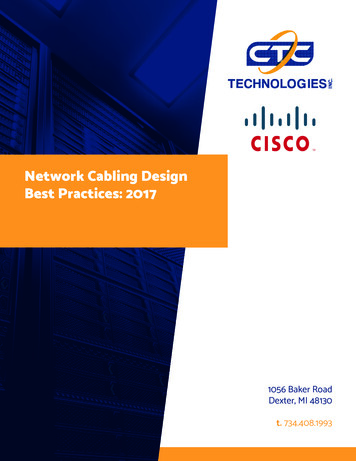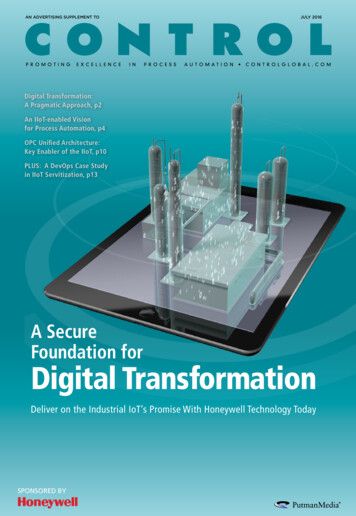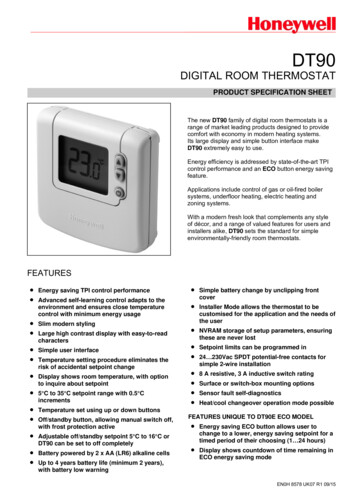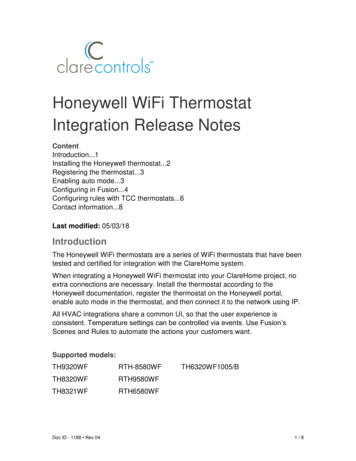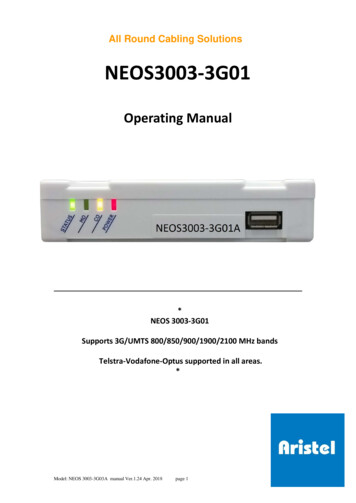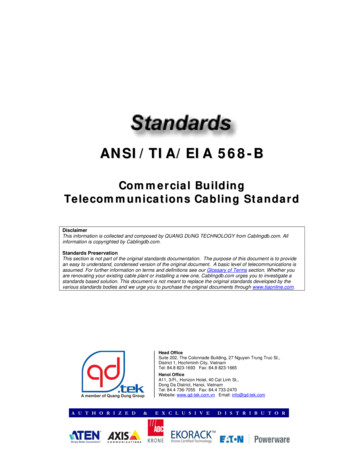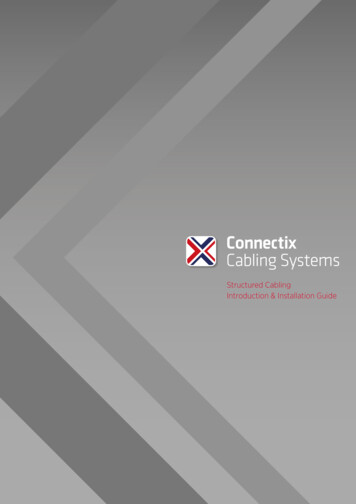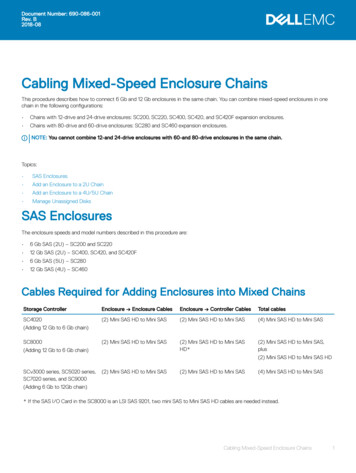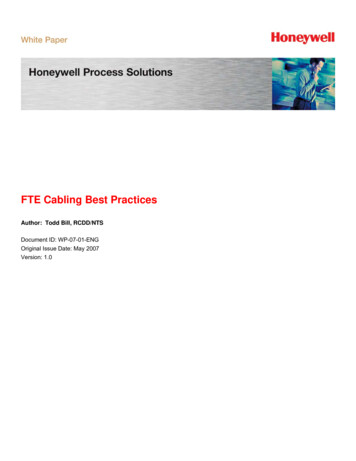
Transcription
FTE Cabling Best PracticesAuthor: Todd Bill, RCDD/NTSDocument ID: WP-07-01-ENGOriginal Issue Date: May 2007Version: 1.0
FTE Cabling Best PracticesTable of ContentsIntroduction and Applicable Standards.3Applicable Standards and Supporting Documents .4Copper Cabling.6Copper Cable Guidelines and Topologies .6Grounding .14Equipment Grounding.14Cable Grounding .14Fiber Optic Cabling .17Fiber Optic Cable Types and Modes .17FO Cable Path Design and Recommendations .21Cable Testing.24Copper Cable Testing.24Fiber Optic Testing .25Summary .27Definitions.281
FTE Cabling Best Practices2Table of FiguresFigure 1 - Typical Screened Cat 6 Jack (image courtesy of The Siemon Company) . 7Figure 2 - Typical Screened Patch Panel (image courtesy of The Siemon Company) . 7Figure 3 - Typical Screened Patch Cables (image courtesy of The Siemon Company) . 8Figure 4 - Typical F/UTP Cable (image courtesy of The Siemon Company) . 8Figure 5 - Typical S/FTP Cable (image courtesy of The Siemon Company) . 8Figure 6 - 568B Pinout . 10Figure 7 - Typical RJ45 Plug (image courtesy of The Siemon Company) . 10Figure 8 - Stainless Steel Faceplate with Industrial Jack and Plug (image courtesy of Panduit Corp) . 11Figure 9 - Industrial Jack and Plug (image courtesy of The Siemon Company) . 11Figure 10 - Industrial Surface Mount Box with Copper and FO Jacks (image courtesy of The Siemon Company) . 11Figure 11 - Water Resistant Faceplate (image courtesy of Panduit Corp). 11Figure 12 - Typical F/UTP Cable System Grounding (image courtesy of The Siemon Company) . 16Figure 13 - Typical Loose Tube Fiber Optic Cable (image courtesy of Corning Cable Systems) . 18Figure 14 - Typical Tight Buffered Fiber Optic Cable (image courtesy of Corning Cable Systems) . 18Figure 15 - Typical ABF Tube Cables and Fiber Bundles (image courtesy of Sumitomo Electric Lightwave Corp) . 19Figure 16 - Typical FO Patch Cable (image courtesy of Panduit Corp). 19Figure 17 - Typical SC Connectors (image courtesy of Panduit Corp) . 20Figure 18 - Exploded View of a Duplex SC Connector (image courtesy of The Siemon Company). 20Figure 19 - Typical ST Connector (image courtesy of Panduit Corp) . 20Figure 20 - Optimal FO Cable Routing . 22Figure 21 - Typical FO Patch Panel (image courtesy of The Siemon Company) . 22Figure 22 - Typical Cisco SFP Fiber Optic Transceiver (image courtesy of Cisco) . 22Figure 23 - Fluke DTX Tester (image courtesy of Fluke Networks). 25Figure 24 - Corning OTDR (image courtesy of Corning Cable Systems) . 25
FTE Cabling Best Practices3Introduction and Applicable StandardsDocument ScopeThis document is intended to provide guidance on the best practices for the design, specification, and installation ofcopper and fiber optic cabling to support Fault Tolerant Ethernet (FTE) systems. While this document is intended tospecifically support FTE, its practices can also be used for any Ethernet implementation. This document is not intendedas a step by step guide to network cabling. Proper cable plant design and installation requires trained professionals suchas those on staff at Honeywell. The recommendations made in this document are not intended to supersede local codesand engineering standards.This document discusses: Horizontal copper cable Copper cable terminations Copper patch cables Grounding Fiber optic cable Fiber optic terminations Fiber optic patch cablesIntended AudienceThis document is intended to assist: Honeywell system consultants, technical assistance centers, and project services personnel Honeywell clients
FTE Cabling Best Practices4Applicable Standards and Supporting DocumentsThis section lists standards and supporting documents from which many of the points in this document are derived.Telecommunication Industry Association/ Electronics Industry Alliance (TIA/EIA) standards are listed in the table below.TIA/EIA standards are copyrighted by and available for purchase from IHS/Global at www.global.ihs.com.Standard NumberStandard TitleTIA-526-7Measurement of Optical Power Loss of Installed Single-mode Fiber Cable PlantTIA-526-14-AOptical Power Loss Measurements of Installed Multimode Fiber Cable PlantTIA/EIA-568-B.1Commercial Building Telecommunications Cabling StandardTIA/EIA-568-B.1-1Commercial Building Telecommunications Cabling StandardPart 1: General RequirementsAddendum 1 – Minimum 4-Pair UTP and 4-Pair ScTP Patch Cable Bend RadiusTIA-568-B.1-2Commercial Building Telecommunications Cabling StandardPart 1: General RequirementsAddendum 2 – Grounding and BondingSpecifications for Screened Balanced Twisted- Pair Horizontal CablingTIA-568-B.1-3Commercial Building Telecommunications Cabling StandardPart 1: General RequirementsAddendum 3 – Supportable Distances and Channel Attenuation for Optical Fiber Applications byFiber TypeTIA-568-B.1-4Commercial Building Telecommunications Cabling StandardPart 1: General RequirementsAddendum 4 – Recognition of Category 6 and 850 nm Laser-Optimized 50/125 µm Multimode OpticalFiber CablingTIA-568-B.1-5Commercial Building Telecommunications Cabling StandardPart 1: General RequirementsAddendum 5 – Telecommunications Cabling for Telecommunications EnclosuresTIA/EIA-568-B.2Commercial Building Telecommunications Cabling StandardPart 2: Balanced Twisted-Pair Cabling ComponentsTIA/EIA-568-B.2-1Commercial Building Telecommunications Cabling StandardPart 2: Balanced Twisted Pair Cabling ComponentsAddendum 1 – Transmission Performance Specifications for 4-pair 100 Ω Category 6 CablingTIA/EIA-568-B.2-3Commercial Building Telecommunications Cabling StandardPart 2: Balanced Twisted Pair Cabling ComponentsAddendum 3 – Additional Considerations for Insertion Loss and Return Loss Pass/Fail DeterminationTIA/EIA-568-B.2-4Commercial Building Telecommunications Cabling StandardPart 2: Balanced Twisted Pair Cabling ComponentsAddendum 4 – Solderless Connection Reliability Requirements for Copper Connecting HardwareTIA-568-B.2-5Commercial Building Telecommunications Cabling StandardPart 2: Balanced Twisted-Pair Cabling ComponentsAddendum 5 – Corrections to TIA/EIA-568-B.2
FTE Cabling Best PracticesStandard NumberTIA-568-B.2-65Standard TitleCommercial Building Telecommunications Cabling StandardPart 2: Balanced Twisted Pair Cabling ComponentsAddendum 6 – Category 6 Related Component Test ProceduresTIA-568-B.2-11Commercial Building Telecommunications Cabling StandardPart 2: Balanced Twisted-Pair Cabling ComponentsAddendum 11 – Specification of 4-Pair UTP and SCTP CablingTIA/EIA-568-B.3Optical Fiber Cabling Components StandardTIA/EIA-568-B.3-1Optical Fiber Cabling Components StandardAddendum 1 – Additional Transmission PerformanceSpecifications for 50/125 µm Optical Fiber CablesTIA-569-BCommercial Building Standard for Telecommunications Pathways and SpacesTIA-598-COptical Fiber Cable Color CodingTIA/EIA-606-AAdministration Standard for Commercial Telecommunications InfrastructureJ-STD-607-ACommercial Building Grounding (Earthing) and Bonding Requirements For TelecommunicationsTIA-758-ACustomer-owned Outside Plant Telecommunications Infrastructure StandardNational Electrical CodeAdditional guidelines can also be found in National Fire Protection Association (NFPA) 70, also known as the NationalElectrical Code. The NEC is available for purchase and copyrighted by IHS/Global at www.global.ihs.com.BICSI TDMMAlso referenced in this document is the Building Industry Consulting Service International (BICSI) TelecommunicationsDistribution Methods Manual (TDMM), available for purchase from and copyrighted by BICSI at www.bicsi.org.Fault Tolerant Ethernet Product SpecificationAnother source of information is the Honeywell Fault Tolerant Ethernet Product Specification EP03-500-300.
FTE Cabling Best Practices6Copper CablingCopper Cable Guidelines and TopologiesIntroductionThis section details the general guidelines that apply to copper network cabling for Honeywell’s FTE networks. The scopeof this document only includes those copper cables specified for data communications use by TIA/EIA-568-B.2-1, ISO/IEC11801 2nd Edition – 2000, and pending TIA/EIA-568-b.2-10.Cable TopologyFTE cabling uses a physical star topology. This means that the workstations are each cabled back to a central switch,with the switch being the center of the star. There are two methods used to make this connection. One method is to usea structured cable plant, which means that there are permanently installed termination devices on either end of ahorizontal cable.In the equipment room, the termination device is usually a patch panel. Patch panels come in two types. One type hasthe jacks permanently installed in the panel and the cable is terminated on the back of the panel, usually in a 110 styleclip. The other type uses the same jack as the workstation outlet and the jack is snapped into a cutout in the panel. Atthe workstation end, the termination device is usually a jack installed in either a faceplate or a surface mounted box.Patch cables are used to connect the jack to the workstation and the patch panel to the switch.The other method is to use a long patch cable that has an RJ45 plug on each end, to directly connect the switch port tothe NIC in the workstation.It’s advisable to use a structured cable approach when: There are a high number of workstations in one area The physical cable distance from the switch to the workstation exceeds 65.6’ (20 m) The workstations are separated from the switch by a physical wallStructured Cable Plant BenefitsThe benefits of a structured cable plant are: Reliability – The horizontal cable is terminated at each end using insulation displacement connections and can betested once the connection is made. Sinc
TIA-569-B Commercial Building Standard for Telecommunications Pathways and Spaces TIA-598-C Optical Fiber Cable Color Coding TIA/EIA-606-A Administration Standard for Commercial Telecommunications Infrastructure J-STD-607-A Commercial Building Grounding (Earthing) and Bonding Requirements For Telecommunications TIA-758-A Customer-owned Outside Plant
